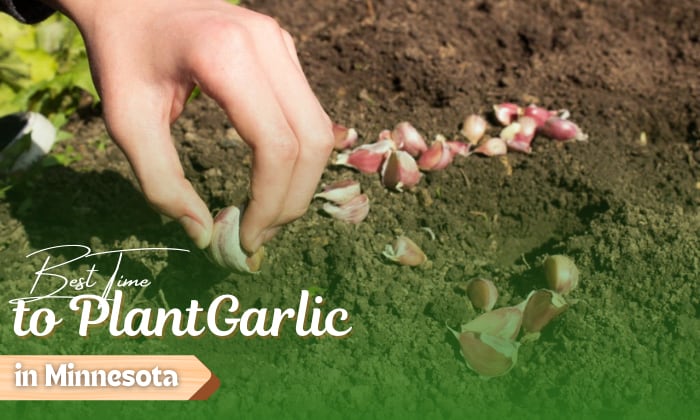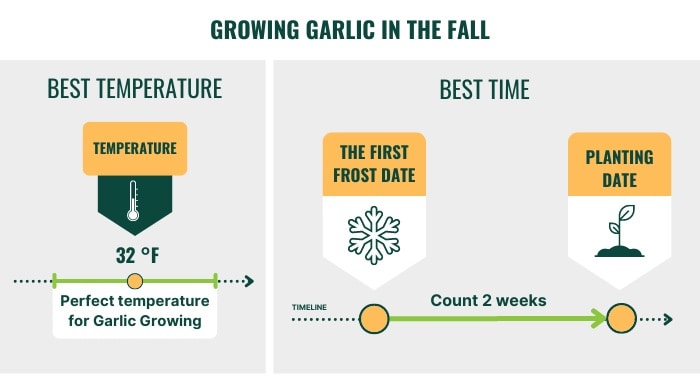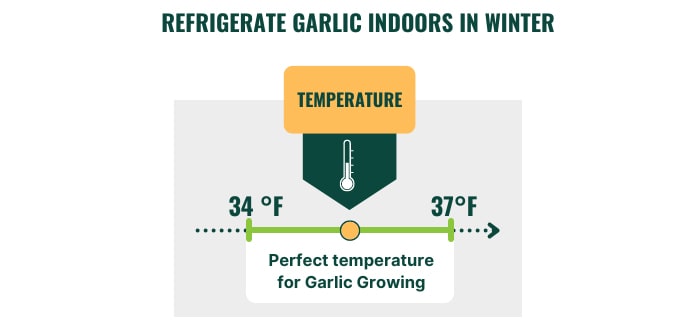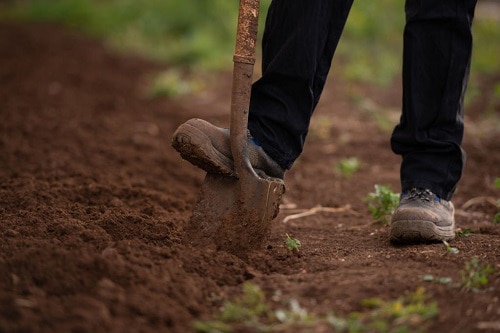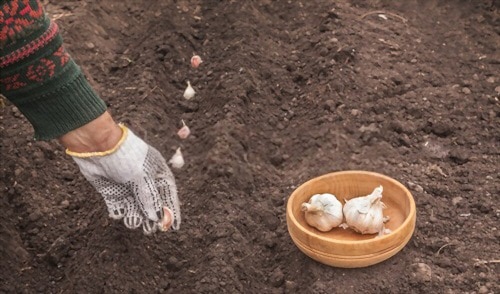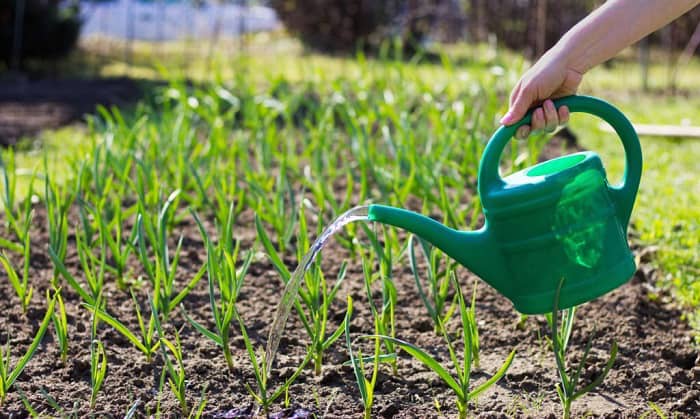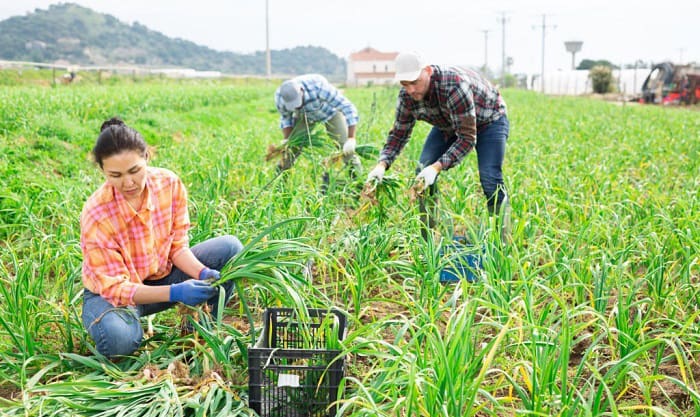Garlic grows very well in Minnesota, to the point that the state has a festival dedicated to this herb almost every year. If you’re looking for a new addition to your fall garden, consider making notes of when to plant garlic in Minnesota.
In short, September 15 to 30 is the ideal garlic cultivation time in northern parts of the state, while October 1 to 14 will suit southern locations more. Note that outside of these dates, you can plant garlic in the fall in MN until the first freeze.
Table of Contents
Best Time to Plant Garlic in Minnesota
1. Plant in the fall from September to the first freeze
Fall is the ultimate garlic growing season, since the cold weather during this time enables the plant to form multiple cloves in the spring instead of one single round for consumption.
If you’re pondering when to sow fall garlic bulbs, one or two weeks after the first frost, when temperatures reach 32℉, is ideal. You can grow them as late as the first freeze or when the soil measures 28 degrees Fahrenheit.
In Minnesota, this would be from mid-September onwards. Below is the planting time for different locations in the state.
| Location | Estimated time for planting fall garlic |
| Thorhult | September 17 – 26 |
| Argyle | September 23 – October 2 |
| Cass Lake | September 21 – October 1 |
| Campbell | September 28 – October 6 |
| Bruno | September 20 – 29 |
| Mankato | October 3 – 14 |
2. Refrigerate garlic indoors in winter and plant them in spring.
If garlic sprouting in fall is impossible for you, i.e., you missed the best window for planting, there’s a spring gardening option you can try.
In this case, make sure to refrigerate the bulbs for three weeks to two months under 34 to 37℉ so that the shoots will grow strong and the scape will fully form once you plant garlic.
It’s also best to put the cloves in plastic bags with holes and inspect them regularly for rot and mold.
After the cold treatment period indoors, sow your crop immediately in spring when the ground is workable. This practice will give garlic more time to develop and form bulbs before summer heat stifles its growth.
3. Planting time in different hardiness zones
Here is the garlic planting time for different hardiness zones in Minnesota, or zone 3 to 5a.
- Zone 3 and zone 4 – October 1 to November 1
- Zone 5a – September and October
4. Is it too late to plant garlic in Minnesota?
The latest time to plant garlic in Minnesota is the first hard freeze. After this date, you’ll have to consider growing garlic indoors in a greenhouse or stratifying it in the fridge for spring planting.
Garlic Planting Instructions
1. Types of garlic to plant and how to select high-quality garlic bulbs for planting
Both hardneck and softneck garlic can grow in Minnesota, though there are some differences between the two to consider. Hardneck garlic produces four to twelve cloves per bulb, while softneck types can have eight to twenty-five cloves.
When picking garlic for fall planting, hardneck bulbs may be better as they are more cold-hardy. They also have bigger cloves than their counterpart, though one disadvantage of this garlic type is that it only lasts for up to six months, while softneck varieties are storable for up to twelve months.
In any case, it’s your decision which garlic for planting you use. Below are some cultivars for both hardneck and softneck cloves.
Remember to buy seed garlic from farms and reputable vendors instead of supermarkets, as grocery produce often has growth inhibitors or comes from climates unlike that of Minnesota.
Hardneck garlic
- Rocambole (German Red, Russian Red, Montana Giant, Spanish Roja)
- Purple Stripe (Chesnok Red, Deerfield Purple, Persian Star)
- Glazed Purple Stripe (Purple Glazer, Red Rezan)
- Marbled Purple Stripe (Metachi, Siberian, Krasnodar Red)
- Porcelain (Armenian, Music, German White, Georgian Fire)
- Asiatic (Japanese, Pyong Vang, Wonha)
- Turban (Xian, Chinese Stripe, Red Janice)
- Creole (Ajo Rojo, Burgundy)
Softneck garlic
- Artichoke (Inchellium Red, New York White, Susanville)
- Silverskin (Silver White, Idaho Silver, Mild French)
2. Preparing the soil
Prepare soil for garlic by testing and amending it as necessary.
You can follow the general recommendation, which is:
- well-composted manure applied at a rate of 1 to 1.5 pounds per square foot
- 50 to 120 pounds of nitrogen spread on an acre—depending on whether your soil is high or low in organic content
- and up to 200 pounds of phosphate and potassium per the same area if your land is lacking in these nutrients.
Note that the nitrogen should be divided into multiple applications, with only ⅓ of the total quantity incorporated into the soil before planting.
Aside from following fertilizer requirements, note that the soil pH for garlic should be between 6 and 7 for optimal growth, with more acidic soil down to 5.8 and a higher garlic pH level of 7.8 being acceptable.
You should also till and loosen the ground before planting, then follow the tips below.
3. Planting techniques
Growing conditions for garlic include six to eight hours of full sun per day, at least 40℉ for vernalization, and a sheltered location with no weeds or nearby trees.
As for how to plant garlic, we recommend sowing cloves with their tips facing up and allowing for 30 inches of distance between rows. Position the cloves six inches apart in the process, and ensure their bases are two to three inches below the soil.
This recommendation on how deep to plant garlic holds true whether you’re sowing them in-ground or growing garlic in pots. The only difference for containers is that the cloves should be three to four inches apart and in planters at least eight inches deep.
Last but not least, remember to combine compost and container soil in a 1:3 ratio while making your soil for garlic in pots.
Maintenance and Care Requirements
Aside from satisfying garlic sun requirements, you should water them with one to two inches of moisture per week to keep the soil from drying out and mulching the ground with four inches of wheat straw or hay.
The mulch is necessary during winter, but you can remove it in spring to help the ground thaw.
During this season, apply the rest of your nitrogen fertilizer for garlic one or two weeks after plant shoots appear.
It’s also vital to remove the scrapes on hardneck garlic once they become curly. This step ensures bigger bulb sizes come harvest time.
Harvesting and Proper Storage
Harvest garlic when 30% of the lower leaves turn brown and the bulbs feel plump with cloves. Pull the garlic out with your hand by holding the shoots, or use a fork to dig them up.
Shake off any dirt and cure the whole plant for three to four weeks under indirect light. The shoots and roots should be trimmed afterward, with the former being no longer than 1.5 inches and the latter measuring up to one inch by the end.
Store garlic for eating by keeping them under room temperature or 32 to 40℉ if you plan to preserve the bulbs for longer. Note that humidity levels should be 60 to 70 percent to prevent dehydration.
Frequently Asked Questions
Where can I buy garlic bulbs for planting?
You can try farmer markets, gardening stores, seed catalogs, and the Minnesota garlic festival, to name a few. The festival happens once a year and lasts a day, with tickets being available for purchase on mngarlicfest.com.
How tall does garlic grow?
Garlic plants can grow up to two feet tall, though 12 to 18 inches or one to 1.5 feet is their average range.
Tips for successful garlic planting in Minnesota
Here are some more garlic planting tips you can follow:
- Do not apply nitrogen in May, as it may encourage foliage rather than bulb growth.
- Avoid watering two weeks before harvest to prevent plant rot, especially if you have wet, heavy soil.
- Buy garlic cloves or bulbils instead of a garlic seedling or seeds, since seeds are not really used and will not resemble their parents once mature.
- Implement a four-year rotation system to prevent fusarium basal rot and nematodes, plus plant disease-free bulbs to avoid white rot. Roguing and removing aphids will help minimize viral infections.
When is garlic in season?
Garlic harvest time in Minnesota is mid-July to early August, depending on the cultivar. If you want to collect your bulbs a bit earlier, grow softneck varieties instead of hardnecks.
Conclusion
When to plant garlic in Minnesota should be your primary concern before growing this crop. Sow garlic in the fall under cold weather and put them in well-drained soil with adequate nutrients and no weeds. Under these conditions, your bulbs should undergo vernalization and grow healthy in spring.

Hi, I am William – Floridayards’ digital content creator. My job is to find answers to all your concerns with thorough research and our team’s expert advice. I will also bring you honest reviews on the best products and equipment for raising your beautiful garden. Please look forward to our work!


